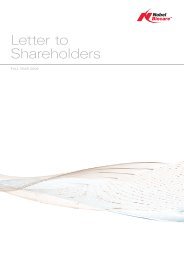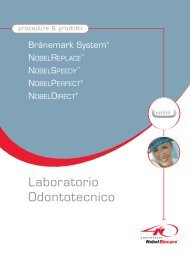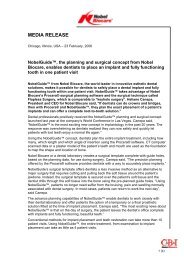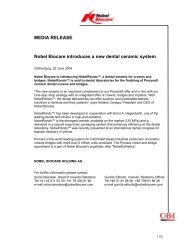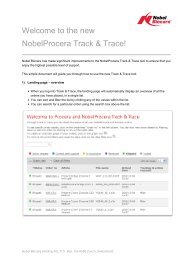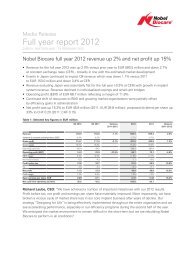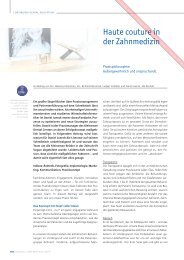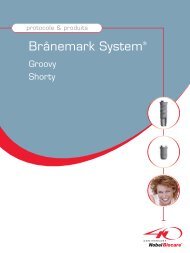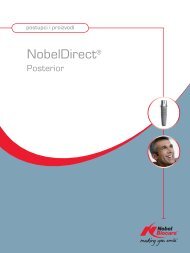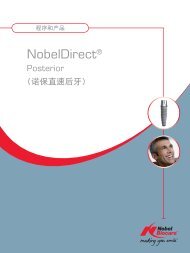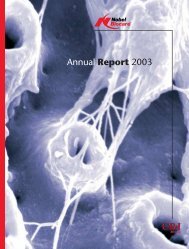Living the Endless Summer - Nobel Biocare News
Living the Endless Summer - Nobel Biocare News
Living the Endless Summer - Nobel Biocare News
You also want an ePaper? Increase the reach of your titles
YUMPU automatically turns print PDFs into web optimized ePapers that Google loves.
<strong>Nobel</strong> <strong>Biocare</strong> NEWSInformation for <strong>the</strong> Osseointegration Specialist Issue 1/2012Designingfor LifeBy Richard Laube, CEOL i v i n g t h e E n d l e s s S u m m e r<strong>Nobel</strong> <strong>Biocare</strong> implant-based solutions provide longevity and exceptional quality of life.Implants from <strong>Nobel</strong> <strong>Biocare</strong>provide <strong>the</strong> foundation for athird dentition that can lastto <strong>the</strong> end of life.By Frederic LoveFor <strong>the</strong> past 50 years, dentists allover <strong>the</strong> world have made astrong case for <strong>the</strong> importanceof keeping one’s teeth. They havesuccessfully argued this case in both<strong>the</strong> popular media and <strong>the</strong> dentaloffice alike.Maintaining good, healthy teethis certainly a worthy goal, but givencurrent demographic trends, keeping<strong>the</strong>m for a lifetime is not always possible,despite <strong>the</strong> impressive achievementsof preventative dentistry and<strong>the</strong> best efforts of <strong>the</strong> patient.Trauma, systemic disease and evennormal wear are just a few of <strong>the</strong> reasonsa tooth may begin to fail.Conscientious brushing, flossingand regular checkups may delay <strong>the</strong>advent of serious problems, but <strong>the</strong>reis likely to come a day—well before<strong>the</strong> tooth falls out of <strong>the</strong> mouth on itsown—when replacement with abone-anchored solution from <strong>Nobel</strong><strong>Biocare</strong> will prove to be a prudent,positively life-changing decision for<strong>the</strong> patient.After half a century of gradual discovery,<strong>the</strong> many benefits of osseointegratedimplants are now wellknown.Implants solve real,widespread problems.Not only do <strong>the</strong>y provide stable,secure solutions that allow patientsto eat virtually anything <strong>the</strong>y want,<strong>the</strong>y preserve <strong>the</strong> patient’s facial appearanceand prevent bone loss,which provides enormous social andemotional benefits in addition to <strong>the</strong>purely physiological ones.Longevity just makes senseWhat is less well-known is that implantsusually make great comparativeeconomic sense as well, partlybecause remaining healthy teeth donot need to be compromised, buteven more so because of <strong>the</strong> characteristiclongevity of implants from<strong>Nobel</strong> <strong>Biocare</strong>.According to Professor Tomas Albrektssonof <strong>the</strong> University of Go<strong>the</strong>nburgin Sweden, <strong>the</strong> maintenanceand replacement costs for an alter-nate lifetime solution—dentures forinstance—should be taken into accountwhen considering implantcosts.“While it’s true that implant-based<strong>the</strong>rapy generally represents a greaterinitial investment in treatmenttime and money than traditionalpros<strong>the</strong>tic solutions,” he said recently,“traditional solutions such as denturesand bridges have recurringcosts in terms of maintenance and<strong>the</strong> often-times deleterious effect<strong>the</strong>y have on <strong>the</strong> adjoining dentitionand bone.”When asked about <strong>the</strong> deepervalue of longevity, he added simply,In this Issue2 Brånemark’s 2nd patient.His implants are stillworking 45 years later.8 TiUnite® Quite simply<strong>the</strong> gold standard.“From <strong>the</strong> earliest days, back in <strong>the</strong>sixties, life-long solutions were alwayswhat we aimed for—and timehas shown that life-long solutions arealso what we achieved.”Of all <strong>the</strong> companies active in <strong>the</strong>field of implant-based pros<strong>the</strong>ticdentistry, none has more experienceor a longer patient follow-up data setthan <strong>Nobel</strong> <strong>Biocare</strong>.Because <strong>the</strong> company understandsthat an implant doesn’t just serve as<strong>the</strong> foundation of a pros<strong>the</strong>tic solution—italso serves to restore ormaintain <strong>the</strong> patient’s self-esteem—you can count on <strong>Nobel</strong> <strong>Biocare</strong> forpromising life-long solutions.
2<strong>Nobel</strong> <strong>Biocare</strong> NEWS Issue 1/2012From <strong>the</strong> EditorA 44-year Success StorySven Johansson has had oral implants longer than anyone else on Earth.Nicolas WeidmannSenior VP Global CommunicationsLongevity comes from carefulplanning, quality productsand treatment, and conscientiousfollow-up.X-ray examinations, a thoroughevaluation of <strong>the</strong> amount of remainingjawbone and a psychologicalexam, Sven was deemed suitable fortreatment.In <strong>the</strong> most recent issue of <strong>Nobel</strong> <strong>Biocare</strong><strong>News</strong>, I wrote that we want thispublication to be your newsletter aswell as ours. From <strong>the</strong> enormousoutpouring of good wishes and substantiveideas for new content that<strong>the</strong> editors have received since <strong>the</strong>n,you are obviously of <strong>the</strong> same mind.Thank you for your kind words andencouraging suggestions!The third dentitionWhen long-term, predictably positiveprognoses are paramount, <strong>the</strong>reis really no substitute for extensive,well-documented experience, whichapplies to suppliers, as well as <strong>the</strong>surgical and pros<strong>the</strong>tic teams.At <strong>Nobel</strong> <strong>Biocare</strong>, we’re preparedto share our experience to supportyour team at every stage of treatment.When you speak to your patientabout a new set of tissue-integratedteeth, you can speak withauthority, confident in <strong>the</strong> knowledgethat <strong>Nobel</strong> <strong>Biocare</strong> stands behindyou.Our wide range of TiUnite surfaceimplants remain at <strong>the</strong> outer edge of<strong>the</strong> envelope for highest initial stabilityand enduring strength.Our company is a lot like thattoo—pioneering, stable and reliable—apartner you can trust.
Issue 1/2012 <strong>Nobel</strong> <strong>Biocare</strong> NEWS3In BriefThere’s an app for thatL a n d m a r k S c i e n c e<strong>Nobel</strong> <strong>Biocare</strong> has <strong>the</strong> longest, most extensive follow-up data set.A free app, not surprisingly called “<strong>Nobel</strong> <strong>Biocare</strong> <strong>News</strong>” now makesit possible for you to stay up-to-date with <strong>the</strong> latest edition of thisnewsletter on your iPad, iPhone or iPod Touch.Just visit <strong>the</strong> App Store on your Apple mobile device and search for“<strong>Nobel</strong> <strong>Biocare</strong> <strong>News</strong>” to download <strong>the</strong> most appropriate app foryour device. Naturally, it’s free of charge.Prefer to read<strong>Nobel</strong> <strong>Biocare</strong> <strong>News</strong> online?Without two pioneeringstudies from 1981 and 1990,implant dentistry might stillbe in its infancy today.By Frederic LoveMany studies have been carriedout on <strong>the</strong> procedures and consequencesof osseointegration sincePer-Ingvar Brånemark treated hisfirst implant patient, Gösta Larsson,47 years ago in 1965. Perhaps nonehas been more widely read than “A 15-year study of osseointegrated implantsin <strong>the</strong> treatment of <strong>the</strong> edentulousjaw” by Ragnar Adell et al, whichwas published in <strong>the</strong> InternationalJournal of Oral Surgery in 1981.In this groundbreaking work, and<strong>the</strong> follow-up study published in1990, Adell and his colleagues meticulouslydocumented <strong>the</strong> high successrates generated by implant treatmentad modum Brånemark and producedan impressive yardstick against whichall subsequent studies would be measured.Dr. Adell, formerly head of <strong>the</strong> Departmentof Oral and MaxillofacialSurgery at <strong>the</strong> Örebro UniversityHospital in Sweden, recently commented,“When we started our workin <strong>the</strong> 1960s, <strong>the</strong> possibility of <strong>the</strong>body permanently retaining a titaniumfixture was not widely accepted.By <strong>the</strong> time our second report on thisstudy was published in 1990, <strong>the</strong> processof osseointegration had becomeaccepted science.”Thanks in large part to <strong>the</strong> pioneeringwork of Adell and his colleagues,<strong>the</strong> viability of <strong>the</strong> routine placementof endosseous implants became wellknownamong readers of dental literaturein <strong>the</strong> 1980s and 90s—and <strong>the</strong>rest, as <strong>the</strong>y say, is history.
4<strong>Nobel</strong> <strong>Biocare</strong> NEWS Issue 1/2012M a n a g i n g S o f t T i s s u e s b y D e s i g nLongevity has many aspects. Good management of <strong>the</strong> soft tissue/implant interface is one of <strong>the</strong>m.Creating an effective andstable soft tissue barrieraround <strong>the</strong> abutment isessential for <strong>the</strong> es<strong>the</strong>ticand functional longevity ofimplant-supported restorations.By Hans GeiselhöringerImplant treatment has proven to bea highly predictable and extremelyreliable option for today’s patients.With sixty years of continuousresearch, innovation and clinical follow-upbehind its implants and relatedcomponents, <strong>Nobel</strong> <strong>Biocare</strong>continues today to provide optimalsolutions for <strong>the</strong> patient, both interms of functional and es<strong>the</strong>ticallypleasing outcomes.<strong>Nobel</strong> <strong>Biocare</strong> designs products forsolutions in harmony with <strong>the</strong> adjacentdentition—and ideally invisibleto <strong>the</strong> human eye.Never complacentDespite <strong>the</strong> extremely high successrates that have resulted from treatmentoptimization over <strong>the</strong> years,<strong>Nobel</strong> <strong>Biocare</strong> continues to activelypursue scientific research with probableclinical consequences.The maintenance and stability of<strong>the</strong> peri-implant tissue architectureis currently a key area of enquiry.While pathways and cellular responsesduring <strong>the</strong> osseointegrationof an implant have been described indetail, questions related to soft tissuestability and ideal treatment protocolsare also being explored [Cairoet al, 2008].Clinicians naturally want to createan effective barrier protecting <strong>the</strong>underlying bone from intraoral microorganismsand <strong>the</strong>ir by-products[Rompen et al, 2006]. In this context,it is generally accepted that <strong>the</strong> tightand stable soft tissue integration ofan implant-based restoration meansa great deal for long-term success.Although clinical protocols havebeen developed to maintain or improvesoft tissue quality and quantityat implant recipient sites [Thoma etal., 2009], it is important to understandthat <strong>the</strong> interaction and interdependenciesof <strong>the</strong> tissue surroundingrestorative components play asvital a role as <strong>the</strong> general anatomicsituation at <strong>the</strong> implant site.<strong>Nobel</strong> <strong>Biocare</strong> has been among <strong>the</strong>first manufacturers to take this criticalinterface between <strong>the</strong> oral cavityand <strong>the</strong> body seriously in every aspectof product development. To ensuresafe, reliable and long-lastingimplant outcomes, <strong>Nobel</strong> <strong>Biocare</strong>emphasizes four product characteristicsthat complement patient-relatedfactors and <strong>the</strong> selection of appropriatetreatment protocols in <strong>the</strong> questfor such outcomes. These are: implant-abutment interface quality of <strong>the</strong> screw joint choice of materials and calsituation (e.g. via tactile feedback).Meeting clinical needs andpersonal preferencesEvery patient is unique, as is everyclinical situation. In terms of personalconfidence and professional preferencesfor protocols and components,every dentist is also unique.Recognizing diverse needs andpreferences, <strong>Nobel</strong> <strong>Biocare</strong> providesa wide variety of implant platformconfigurations. With recent <strong>Nobel</strong>-Replace line extensions featuringconical connection and platformshifting interfaces, <strong>Nobel</strong> <strong>Biocare</strong> hasonce again proven its commitmentto meeting every clinician’s needs.<strong>Nobel</strong> <strong>Biocare</strong> incorporated newconnections into <strong>the</strong> world’s mostversatile and widely used implantsystem in order to facilitate <strong>the</strong> use ofa variety of established and highlypredictable treatment protocols.To put it ano<strong>the</strong>r way, <strong>Nobel</strong> <strong>Biocare</strong>developed and launched implantswith conical connection andplatform shifting in order to providenew tools for soft tissue managementand <strong>the</strong> preservation of <strong>the</strong> crestalbone.Platform shifting provides a narrowerdiameter pros<strong>the</strong>tic componenton a wider diameter implant platform(see figure 1 on <strong>the</strong> next page and <strong>the</strong>accompanying case study by Dr.David Lustbader). This creates an exposedridge on <strong>the</strong> implant platformwhere <strong>the</strong> soft tissue can develop.Implants with platform shifting increase<strong>the</strong> interface between biologicalwidth and retention and may actas a “stop” preventing tissue recession.Literature shows that utilizingplatform shifting results in both significantlyless radiographically detectablebone loss in humans and bettersoft tissue support andmaintenance in <strong>the</strong> es<strong>the</strong>tic zone[Atieh MA et al, 2010; Canullo et al,2007; López-Mari et al, 2009].<strong>Nobel</strong>Replace <strong>Nobel</strong>Replace <strong>Nobel</strong>ReplaceThe <strong>Nobel</strong>Active conical connection is exceptionally strong, makingfor a tight seal achieved by <strong>the</strong> use of a special grade of commercially puretitanium and <strong>the</strong> radial design of <strong>the</strong> connection, which distributes <strong>the</strong>forces deep within <strong>the</strong> robust core of <strong>the</strong> implant.Tapered Platform Shift Conical ConnectionThe newly launched <strong>Nobel</strong>Replace Platform Shift and <strong>Nobel</strong>ReplaceConical Connection demonstrate strength values in <strong>the</strong> same rangeas <strong>Nobel</strong>Replace Tapered Groovy when evaluated mechanically using ISOtests.Decisive design featuresThe back-tapered collar of <strong>the</strong><strong>Nobel</strong>Active regular platform implanthas been designed to maximize<strong>the</strong> volume of bone at <strong>the</strong> alveolarcrest and to improve soft tissue support.Tissue management is fur<strong>the</strong>rsupported by <strong>the</strong> built-in platformshift and <strong>the</strong> internal conical connection.The expanding tapered <strong>Nobel</strong>-Active implant body with doubleleadthread is designed to condensebone gradually to provide high initialstability and support for immediateloading.The results of a multi-centerstudy—encompassing 64 partially orfully edentulous patients receiving117 <strong>Nobel</strong>Active implants in 12 centers—showthat <strong>the</strong> marginal bonelevel as well as <strong>the</strong> soft tissue level isstable two years after implant insertion.The study demonstrates that<strong>Nobel</strong>Active can be placed under demandingimmediate loading conditionsas it provides stable bone andsoft tissue levels after two years offunction [Martinez-de Fuentes et al,2010].The perfect balanceWhile <strong>the</strong> implant platform-abutmentinterface design plays a significantrole in a stable and lasting connection,o<strong>the</strong>r design considerationshave also been taken to reduce detrimentaleffects on <strong>the</strong> peri-implanttissues. Bona fide precision fit and<strong>the</strong> ingenious design of <strong>the</strong> <strong>Nobel</strong><strong>Biocare</strong> abutment screw minimizemicromotion, for example.The achievement of proper fit betweenmating components is governedby an apparent paradox: On<strong>the</strong> one hand, precision is paramount,on <strong>the</strong> o<strong>the</strong>r, acceptable tolerancesmake <strong>the</strong> seating of pros<strong>the</strong>ticcomponents possible. In defining acceptabletolerances, <strong>Nobel</strong> <strong>Biocare</strong>has specified figures that facilitatepassive fit yet remain well below <strong>the</strong>critical threshold limits that wouldlead to micromotion and ultimatelyto loosening of <strong>the</strong> implant-abutmentjoint. (Read more about micromotionin Professor John Brunski’s articleon page 14.)An inconspicuous hero:<strong>the</strong> TorqTite screwIn <strong>the</strong> early days of implant dentistry,one of <strong>the</strong> most commonly reportedmaintenance needs for implant restorationswas retightening or changing<strong>the</strong> abutment screws [Goodacre et al,2003]. <strong>Nobel</strong> <strong>Biocare</strong>’s engineerssolved <strong>the</strong> problem by developing ascrew with features outclassing anyo<strong>the</strong>r retaining screw.O<strong>the</strong>r implant systems have triedto introduce similar screws, but <strong>the</strong>features of <strong>Nobel</strong> <strong>Biocare</strong>’s TorqTitescrews remain unique. To keep <strong>the</strong>implant and abutment interface connectedand to prevent any rotationalmovement upon load application,special features have been integratedinto its design.For one thing, <strong>the</strong> screw is manufacturedfrom a specific titaniumalloy and coated with a carbon layerthat reduces friction between <strong>the</strong> internalscrew-threads of <strong>the</strong> implantand <strong>the</strong> threads of <strong>the</strong> retainingscrew.A reduction of friction is namelyneeded to reach <strong>the</strong> pre-torque valuesrequired to create pre-tension in <strong>the</strong>screw shank. (See <strong>the</strong> Tips and Techniquesarticle by Dr. Chandur Wadhwanion page 11.) <strong>Nobel</strong> <strong>Biocare</strong>’sTorqTite screws have been designedand tested to occupy <strong>the</strong> center of<strong>the</strong> proper torque zone.If screw threads ran all <strong>the</strong> way upto <strong>the</strong> head of <strong>the</strong> screw—as <strong>the</strong>y doin many o<strong>the</strong>r implant systems—<strong>the</strong>shaft could not act as <strong>the</strong> pre-loadspring necessary to ensure <strong>the</strong> longevityof <strong>the</strong> screw-joint.
Issue 1/2012 <strong>Nobel</strong> <strong>Biocare</strong> NEWS5P o p u l a r, W e l l - p r o v e n C o n c e p tExperience <strong>Nobel</strong>Replace® Platform Shift from <strong>the</strong> clinical point of view.UpcomingEventsPlatform shifting, or platformswitching, is a concept thathas come into <strong>the</strong> mainstreamas it has become anintegral feature of some of<strong>Nobel</strong> <strong>Biocare</strong>’s most popularimplants.By Dr. David LustbaderVisit <strong>Nobel</strong> <strong>Biocare</strong> at eventsaround <strong>the</strong> world. They provide agreat opportunity for observing<strong>the</strong> latest innovations andscientific research.2012IDEM Singapore20–22 AprilSingaporeOriginally described by Dr.Lazzara, platform shifting isa concept that involves aninward horizontal repositioning of<strong>the</strong> implant-abutment interface (figure1). This connection shifts <strong>the</strong>perimeter of <strong>the</strong> implant-abutmentjunction towards <strong>the</strong> center of <strong>the</strong>implant, creating a horizontal componentfor <strong>the</strong> total linear distancebetween <strong>the</strong> abutment and crestalbone required for biologic width.This allows for higher tissue volumeand vascularization, ultimatelyleading to more stable crestal boneheights and interdental papilla.Most studies show that a horizontalcomponent of about 0.5 mm resultsin significantly less radiographicallydetectable crestal bone loss andbetter soft tissue support in <strong>the</strong> es<strong>the</strong>ticzone. Platform shifting can beaccomplished with <strong>the</strong> <strong>Nobel</strong>ReplacePlatform Shift tri-channel (figure 2)or <strong>Nobel</strong>Replace Conical Connection(figure 3), which is identical to<strong>the</strong> <strong>Nobel</strong>Active configuration.I have had <strong>the</strong> good fortune to beable to place both <strong>the</strong> <strong>Nobel</strong>ReplacePlatform Shift and Conical Connectionimplants during <strong>the</strong> pre-launchand evaluation stages. To date, ourpractice has placed over one hundredof <strong>the</strong>se implants and havefound <strong>the</strong> marginal bone levels andsoft tissue es<strong>the</strong>tics to be excellent.The surgical placement and instrumentationis virtually identicalto <strong>the</strong> standard <strong>Nobel</strong>Replace system,making it ideal from a stafftraining and surgical armamentariumstandpoint. A simple case illustrationwill demonstrate <strong>the</strong> ease ofuse and predictability.Platform shifting in practiceThe case illustrated in this page is of a78-year-old man who had a verticaland horizontal fracture through tooth#9 (FDI 21), evident clinically and on<strong>the</strong> pre-op film (figures 4 and 5). Thetreatment plan was to remove #9 andto immediately place a <strong>Nobel</strong>ReplacePlatform Shift with immediate load.This implant was chosen to maximizesoft tissue volume in hopes ofFig. 1. Platform shifting has beendesigned to maximize soft tissuevolume.overcoming any negative tissue influencesfrom a large maxillary frenum.The tooth was atraumaticallyremoved and a surgical guide wasfabricated to assist with depth placementof <strong>the</strong> implant.The osteotomy was started withtwist drills, but finished with osteotomesto preserve <strong>the</strong> buccal plate. A5 x 13 mm <strong>Nobel</strong>Replace PlatformShift implant was placed using <strong>the</strong>4.3 mm implant driver, placing <strong>the</strong>implant to just below <strong>the</strong> facial heightFig. 4–5. Pre-op clinical and radiographic views.Fig. 8. Temporary crown at sixweeks post-op.Fig. 2. <strong>Nobel</strong>Replace PlatformShift. The ease of use of <strong>the</strong>internal tri-channel connectioncombined with built-in platformshifting.Fig. 6–7. Extraction site and implant with healing abutment.Fig. 10. CAD/CAM abutmentfabrication using <strong>Nobel</strong>ProceraSoftware.Fig. 9. Impression appointment12 weeks post-op.Fig. 11. Final crown insertion at 14weeks. Note continued excellentbone level preservation.Fig. 3. <strong>Nobel</strong>Replace ConicalConnection. The original taperedimplant body combined with <strong>the</strong>tight conical connection and built-inplatform shifting.of <strong>the</strong> crestal bone to take full advantageof <strong>the</strong> platform shift.A 6 x 3 mm healing abutment, 4.3series was placed on <strong>the</strong> implant (figure7), and <strong>the</strong> patient was <strong>the</strong>n seenby his restorative dentist for immediatetemporization (figure 8).The patient functioned on <strong>the</strong> immediatetemporary for 12 weeks, atwhich time <strong>the</strong> final impression wastaken (figure 9). Note that at all times<strong>the</strong> integrity of <strong>the</strong> marginal bone waspreserved.A CAD/CAM custom abutmentwas fabricated using <strong>the</strong> <strong>Nobel</strong>ProceraScanner and Software (figure 10).The final crown was inserted at 14weeks (figure 11). As can be seen in<strong>the</strong> final restoration (figure 12), tissuelevel integrity is preserved.Our practice has acquired a greatdeal of experience with <strong>Nobel</strong>ReplacePlatform Shift and Conical Connectionimplants over <strong>the</strong> past year. Wehave seen superior es<strong>the</strong>tic resultswith excellent preservation of soft tissueand crestal bone. Although <strong>the</strong> follow-upperiod is relatively short, preliminaryresults are very encouraging.This is an excellent addition to <strong>the</strong><strong>Nobel</strong> family of implant products.
6<strong>Nobel</strong> <strong>Biocare</strong> NEWS Issue 1/2012M e e t i n g O n e - o f - a - k i n d P a t i e n t N e e d sCustom-made devices from <strong>Nobel</strong> <strong>Biocare</strong> can make a decisive difference when no one else has a solution to offer.For over 20 years, <strong>Nobel</strong><strong>Biocare</strong> has been offering aunique service to itsworldwide customer basethat you may not be aware of.A special custom-madedevice service exists inSweden that makes itpossible to create a one-timesolution for a one-timepatient need.By Jim MackNo matter how far technologymay advance your favoriteproducts, you will always be leftwanting more. But when it comesto a special patient need, or even anemergency, you may not be able tofind your “dream product” in <strong>the</strong>marketplace.With <strong>Nobel</strong> <strong>Biocare</strong>’s custommadedevice service, all you have todo is ask. Your custom-made devicecan be created in a matter of weeks—or even less in cases of extreme medicalemergency.Not your normal solutionCustom-made solutions are tailoredto fit a unique and one-time patientneed. These special solutions extendbeyond <strong>the</strong> typical es<strong>the</strong>tic circumstancesand can also be used to assisttrauma victims, including those recoveringfrom such serious injuriesas gunshot wounds. (See article on<strong>the</strong> facing page.)One caveat may be in order: Thisservice is not meant to provide individuallydesigned products for doctorsto have in stock for similar indications.There are no catalogs, norare <strong>the</strong>re any product lists.While each item is reviewed by <strong>the</strong><strong>Nobel</strong> <strong>Biocare</strong> regulatory department,custom devices are not CE marked as<strong>the</strong>y are intended for specific patientsand not for a general market release.For regulatory reasons, an order isbased on a prescription filled out for anamed patient only.Each device is classified into oneof 15 product categories, under <strong>the</strong>headings of “abutment components”,“restorative auxiliary”, “surgery components”and “miscellaneous” (whichincludes maxillofacial surgical components).“I have used <strong>the</strong> custom device workshop at <strong>Nobel</strong><strong>Biocare</strong> for many years to provide me andmy patients with bespoke parts to solve large andsmall problems alike.”— Dr. Andrew Dawood, London, United KingdomAttention to detailThe production process typicallytakes around five weeks, unless ano<strong>the</strong>rtimeline is decided upon. Eachcase that comes in requires great attentionto detail and must be assessedindividually according toKarin Dahlmo, who manages <strong>the</strong>Custom Devices and ReplacementParts department at <strong>Nobel</strong> <strong>Biocare</strong> inGo<strong>the</strong>nburg, Sweden. “We must lookclosely at all <strong>the</strong> circumstances ofeach case. Decisions are made basedupon medical, legal and regulatoryrequirements.”As <strong>the</strong> founder of modern implantdentistry, with more than 45 years at<strong>the</strong> forefront of implant-based restora-tions, <strong>Nobel</strong> <strong>Biocare</strong> takes <strong>the</strong> responsibilityof its heritage very seriously.The experience and productioncapability reflected in Dahlmo’sdepartment put <strong>the</strong> company in aunique position to support cliniciansworldwide in <strong>the</strong>ir efforts to improve<strong>the</strong>ir patients’ quality of life.In addition to simply recreatingdiscontinued products, <strong>Nobel</strong> <strong>Biocare</strong>can fur<strong>the</strong>r cater to needs beyondits core assortment.In many circumstances, clinicalindications may be so complex thatonly sophisticated custom-made solutionsare <strong>the</strong> right answer.
Issue 1/2012 <strong>Nobel</strong> <strong>Biocare</strong> NEWS7C r o s s - b o r d e r C o o p e r a t i o n S o l v e s C a s eSolution for gunshot victim made possible by custom-made devices and 3D software from <strong>Nobel</strong> <strong>Biocare</strong>Reconstruction of 3D defectsin <strong>the</strong> anterior maxilla arechallenging in terms of bothrestored function andes<strong>the</strong>tics. The Chairman of <strong>the</strong>Department of Oral & MaxillofacialSurgery at UmeåUniversity in Sweden sends us<strong>the</strong> following treatment report.By Professor Stefan LundgrenA24-year-old female waswounded by a gunshot duringa robbery in a store. The9 mm bullet, fired from <strong>the</strong> distanceof a few meters, resulted in a significant3D-defect in <strong>the</strong> left upper lipand maxilla. The bullet penetrated<strong>the</strong> throat and was stopped by <strong>the</strong>Fig. 1. Patient with a significant defect in <strong>the</strong> left maxilla. The patient wasinjured from a gun shot.Fig. 2. Predominantly cortical bonegraft was harvested from <strong>the</strong> iliaccrest, seen here in place in <strong>the</strong>defect for a 3D reconstruction of<strong>the</strong> bone that will later host threeimplants.Fig. 5. Segmental anterior maxillaryosteotomy with <strong>the</strong> bone blockincluding <strong>the</strong> three implants. Acustom-designed distraction deviceacted also as a temporary bridgeduring active distraction and <strong>the</strong>consolidation period.cervical vertebrae a few mm from <strong>the</strong>spinal cord. The 24-year-old Estonianfemale was seen in a consultation visitin Tallin by Dr. Juha Peltola, an oral &maxillofacial surgeon in private practicein Helsinki, who referred <strong>the</strong> patientfor treatment planning—and ifpossible, treatment—to <strong>the</strong> Departmentof Oral & Maxillofacial Surgery,Umeå University Hospital.The initial treatment planning wasdone by Dr. Peltola toge<strong>the</strong>r with meand Dr. Hans Nilson, <strong>the</strong> planned restorativedentist from <strong>the</strong> Departmentof Prostetic Dentistry at Umeå.The first step was a contact with<strong>Nobel</strong> <strong>Biocare</strong> to help with <strong>the</strong> fundingof travel expenses, laboratorycosts and components. Financial negotiatonswere carried out with <strong>the</strong>University Hospital and The DentalFig. 3. Implants, placed with <strong>the</strong>aid of <strong>the</strong> <strong>Nobel</strong>Guide concept.Fig. 4. Virtual computerizedplanning showing <strong>the</strong> three plannedimplants in correct interrelatedpositions, but in a remote site.School in order for us to be able tocomplete <strong>the</strong> planned treatment at nocost to <strong>the</strong> patient, who was unable too<strong>the</strong>rwise finance it.Bone graft firstUnder general anes<strong>the</strong>sia, a bonegraft was harvested from <strong>the</strong> anteriorleft iliac crest and placed in <strong>the</strong> defectin order to provide good bone architecturefor <strong>the</strong> later placement of implants.Three months later, a CT with a radiologicalguide was performed inHelsinki and <strong>the</strong> implant placementwas virtually planned with <strong>Nobel</strong>-Guide treatment planning softwarein collaboration with Matts Anderssonand Andreas Pettersson at <strong>the</strong><strong>Nobel</strong> <strong>Biocare</strong> office in Go<strong>the</strong>nburg.We placed <strong>the</strong> implants in <strong>the</strong> officeof Dr. Peltola in Salora, Finland,with help from <strong>the</strong> surgical guide derivedfrom <strong>the</strong> preoperative <strong>Nobel</strong>-Guide planning. At this point, <strong>the</strong>implants were placed in good bone,with a nice bone architecture, yetremote from <strong>the</strong> planned bridge!Placement of <strong>the</strong> implants—as wellas <strong>the</strong> planned final navigation of <strong>the</strong>anterior maxillary segment, including<strong>the</strong> grafted bone and <strong>the</strong> three implants—wasall performed in <strong>the</strong> virtual3D environment. The implantswere allowed to heal for two monthsbefore <strong>the</strong> distraction surgery was initiated.The external distraction devicewas custom-designed by <strong>the</strong> Departmentof Early Development, <strong>Nobel</strong><strong>Biocare</strong> in Go<strong>the</strong>nburg.A distraction deviceThe custom designed distraction devicewas divided in two parts. A smallProcera bridge connected <strong>the</strong> threeimplants in order to create a systemof two rods which were parallel andin <strong>the</strong> direction of <strong>the</strong> planned vector.The second part of <strong>the</strong> distractiondevice was incorporated in <strong>the</strong> temporarybridge, which was retainedwith temporary cement, as a splint,on <strong>the</strong> posterior dentition.The third surgical phase was performedin Umeå under local anes<strong>the</strong>siaand I.V. sedation. The anteriormaxillary segment was osteotomizedand <strong>the</strong> bone segment, including <strong>the</strong>three implants, was mobilized. Then<strong>the</strong> different parts of <strong>the</strong> distractiondevice were assembled, <strong>the</strong> temporarybridge was cemented to <strong>the</strong> posteriormaxillary teeth, and <strong>the</strong> surgicalwound was closed with sutures.The patient went home to Tallinn<strong>the</strong> day after surgery and <strong>the</strong> activedistraction was started ten days afterFig. 6. Left: Before <strong>the</strong> treatment. Right: After completed bone grafting,implant insertion and distraction osteotomy.Fig. 7. Permanent zirconium/ceramic bridge in place.Fig. 8. Bridge delivery followed by lip correction.<strong>the</strong> surgical intervention. The activedistraction over ten days was assistedby <strong>the</strong> patient’s dentist in Tallin andwas followed by two months of consolidationbefore <strong>the</strong> distraction devicewas removed, and <strong>the</strong> patientcould receive a temporary bridge inTallin.Then <strong>the</strong> patient came to Umeå for<strong>the</strong> processing of <strong>the</strong> final bridge,which was temporarily provided.After ano<strong>the</strong>r few weeks, she returnedagain for <strong>the</strong> final adjustmentof <strong>the</strong> bridge. After delivery of <strong>the</strong>corrected bridge we did <strong>the</strong> final surgicalcorrection of <strong>the</strong> upper lip.Note on techniqueAccording to this treatment protocol,we place <strong>the</strong> implants in <strong>the</strong> bonegraft to allow optimal placement in<strong>the</strong> bone regardless of <strong>the</strong> final implantposition. If <strong>the</strong> implants arecorrectly positioned in relation toeach o<strong>the</strong>r, <strong>the</strong> bone segment (including<strong>the</strong> implants) can later betransported to <strong>the</strong> final correct positionfor <strong>the</strong> temporary bridge. Thisrequires treatment planning performedin a virtual 3D environment.The sequence of treatment provides anumber of benefits.The distraction device, retained by<strong>the</strong> implants, can be removed in anoninvasive way as <strong>the</strong> device is extra-mucosallypositioned. The distractiontechnique increases not onlybone tissue but also mucosal volume.With <strong>the</strong> correct technique, <strong>the</strong>width of <strong>the</strong> keratinized mucosa canbe increased both on <strong>the</strong> newlyformed alveolar process and around<strong>the</strong> implants.
8<strong>Nobel</strong> <strong>Biocare</strong> NEWS Issue 1/2012TiUnite ® – A Unique BiomaterialA remarkable set of images displays <strong>the</strong> process of osseointegration as it’s never been revealed before.Implant surface propertiesare of key importance forinitial tissue interactions, <strong>the</strong>acceleration of bone healingand osseointegration. TiUniteis titanium oxide renderedinto an osteoconductivebiomaterial through sparkanodization. New insightsexplain how TiUnite interactswith tissue and why itremains <strong>the</strong> osteoconductivesurface of choice.By Drs. Peter Schüpbachand Roland GlauserPlatelet activation: Immediately following implant insertion, blood proteins and platelets are attracted by <strong>the</strong> negatively charged TiUnite surface.The activated platelets form pseudopodia and clump toge<strong>the</strong>r to form aggregates.<strong>Nobel</strong> <strong>Biocare</strong> first introducedTiUnite to <strong>the</strong> market in2000 on its Brånemark Systemimplants, and <strong>the</strong>n applied itto Replace Select in 2001. Today,TiUnite is available on all <strong>Nobel</strong><strong>Biocare</strong> implants, including thosewith machined collars.Unlike implants with machinedsurfaces, TiUnite has clinically demonstrated<strong>the</strong> ability to increase <strong>the</strong>predictability and speed at whichdental implants osseointegratethrough osteoconductive bone formation(Glauser et al, 2001).TiUnite is formed by spark anodizationin an electrolytic solutioncontaining phosphoric acid. This resultsin a thickened titanium oxidelayer (up to 10 microns) and a moderatelyrough porous surface topography(Ra 1.2). TiUnite contains anataseand rutile, <strong>the</strong> most importanttitanium oxides, and is <strong>the</strong>reby ahighly crystalline biomaterial. Studieshave also shown <strong>the</strong> presence ofphosphorus in <strong>the</strong> oxide layer (Lausmaa& Hall, 2000; Schüpbach et al,2005). Thus, TiUnite may have botha topography-related as well as achemistry-related effect on osseointegration.This article explains how TiUniteinteracts with living tissue and accelerateswound healing.S&ESafety and EfficacyAn inevitable chronologyWound healing comprises a cascadeof events that <strong>the</strong> body brings intoplay to resolve injury. Nature’s firstpriorities are to stop bleeding, restorefunction and to prevent infection.Generally, <strong>the</strong> wound-healingevents are grouped into four phases:hemostasis, inflammatory, proliferative/repair,and remodeling.Hemostasis (0 to 10 minutesfollowing implant placement)TiUnite shows its strength already at<strong>the</strong> time of placement of an implant:Within seconds, blood proteins andplatelets are attracted to <strong>the</strong> negativelycharged TiUnite surface andbecome immediately activated.This first step is crucial for <strong>the</strong>wound healing. Their activation isfollowed by <strong>the</strong> release of growthfactors, such as platelet-derivedgrowth factor (PDGF) and transforminggrowth factor beta (TGF-b).These factors play a crucial role in<strong>the</strong> regulation of <strong>the</strong> wound-healingcascade (Park JY et al, 2001; MarxRE, 2000). During <strong>the</strong> first ten minutes,fibrin—<strong>the</strong> reaction product ofthrombin and fibrinogen—will bereleased at <strong>the</strong> wound site.The resulting stabilized blood clotreveals improved adherence to <strong>the</strong>moderately rough TiUnite surfacewhen compared to smooth surfaceimplants.Day 1 to 2The inflammatory phaseThe inflammatory phase beginsminutes following <strong>the</strong> implant insertionand continues for approximatelytwo days.Neutrophils are <strong>the</strong> first cells attractedby chemical signals releasedby <strong>the</strong> platelets, followed by macrophages.Both cell types will phagocytizesmall bone debris. The fibrinwill be broken down by <strong>the</strong> enzymeplasmin and <strong>the</strong> debris will also beremoved by <strong>the</strong> leukocytes. Fibrinolysisstarts already during hemostasisbut is slower and <strong>the</strong>reby contributesto its regulation.The breakdown of <strong>the</strong> fibrin clotcreates <strong>the</strong> room in <strong>the</strong> wound siteneeded for <strong>the</strong> invasion of fibroblastand <strong>the</strong>reby <strong>the</strong> forming of <strong>the</strong> provisionalmatrix (Schüpbach et al, inpreparation).Day 3 to 5The proliferative/repair phaseThe proliferative phase is characterizedby granulation tissue formation,angiogenesis, collagen deposition,and wound contraction. Ingranulation tissue formation, fibroblastsinvade <strong>the</strong> wound and form amore on following pageHemostasis: Blood clot formation will be accomplished by <strong>the</strong> formation of <strong>the</strong> fibrin matrix. Activated platelets (arrows) become embedded in <strong>the</strong> matrix. Eventually, <strong>the</strong> platelets start to releasegranules containing full batteries of enzymes and growth factors needed for <strong>the</strong> wound healing.
Issue 1/2012 <strong>Nobel</strong> <strong>Biocare</strong> NEWS9Recent FindingsTiUnite ® 10-year, Immediate LoadingEarly wound healing: The fibrin matrix will be broken down by <strong>the</strong> enzyme plasmin and <strong>the</strong>ir debris will beremoved by neutrophils (green, left) and later macrophages. The healing site will be invaded by fibroblasts and <strong>the</strong>blood clot replaced by <strong>the</strong> provisional extracellular matrix. Eventually, osteogenic cells (red arrows) stream to <strong>the</strong>implant surface. Once <strong>the</strong>y reach it, <strong>the</strong>y migrate by active locomotion using <strong>the</strong>ir pseudopodia and <strong>the</strong> open poresas attachment points (yellow arrow) to <strong>the</strong> front of bone formation.Osteoconductive bone formation: Human histology six months following insertion shows bone anchored in <strong>the</strong>TiUnite pores (left). In extraction sockets, newly formed bone crosses <strong>the</strong> gap between local bone (LB) and <strong>the</strong>implant surface by distance osteogenesis (middle, yellow arrow). As soon as <strong>the</strong> implant surface is reached, newbone spreads over <strong>the</strong> surface by contact osteogenesis (middle, red arrow) characterized by woven bone depositeddirectly on and along <strong>the</strong> surface (right).Already available as an ePub ahead of publication, anarticle in “Clinical Implant Dentistry and Related Research”documents <strong>the</strong> 10-year outcome of immediately loadedimplants with <strong>the</strong> TiUnite surface.“10-Year Follow-Up of Immediately Loaded Implants with TiUnitePorous Anodized Surface,“ by Drs. Marco Degidi, Diego Nardi andAdriano Piattelli reports on a prospective study <strong>the</strong> authors carried outto assess <strong>the</strong> 10-year performance of TiUnite implants supportingfixed pros<strong>the</strong>ses placed with an immediate loading approach in bothpostextractive and healed sites.All <strong>the</strong> patients in this study received a fixed provisional restorationsupported by parallel design, self-tapping implants with a TiUnite surface,and an external hexagonal connection.Success and survival rate for restorations and implants, changes inmarginal peri-implant bone level, probing depth measurements, biologicalor technical complications, and any o<strong>the</strong>r adverse event wererecorded at yearly follow-ups.The implants placed in healed and post-extractive sites, respectively,achieved a 98.05% and a 96.52% cumulative survival rate and <strong>the</strong>authors conclude that positive results—in terms of bone maintenancein <strong>the</strong> long-term perspective—are to be expected using immediatelyloaded implants with a TiUnite surface in both post-extractiveand healed sites when adequate levels of oral hygiene are maintained.www.nobelbiocare.com/tiunite-10-year-abstractfrom <strong>the</strong> previous pageprovisional extracellular matrix(ECM) by secreting collagen andfibronectin. In angiogenesis, newblood vessels are formed by vascularendo<strong>the</strong>lial cells. In contraction, <strong>the</strong>wound is made smaller by <strong>the</strong> actionof myofibroblasts, which establish agrip on <strong>the</strong> wound edges and contract<strong>the</strong>mselves.Now <strong>the</strong> benefit of <strong>the</strong> TiUnitetopography comes into play as <strong>the</strong>moderately rough surface diminishes<strong>the</strong> ECM retraction from <strong>the</strong> surface—whencompared to smoothsurfaces—and inhibits its retractionfrom <strong>the</strong> surface. This is a prerequisitefor osteoconductive bone formationas osteogenic cells, again attractedby <strong>the</strong> chemical signals of <strong>the</strong>platelets, may reach <strong>the</strong> surface onlyif <strong>the</strong> ECM remains attached.Day 5 to 7 – Osteoconductivebone formationOnce <strong>the</strong> osteogenic cells havereached <strong>the</strong> TiUnite surface, <strong>the</strong>y migrateto <strong>the</strong> front of bone formation,i.e. where wound edges of <strong>the</strong> localbone of <strong>the</strong> osteotomy are in contactwith <strong>the</strong> implant surface or wherebone newly formed by distance osteogenesisalready has reached <strong>the</strong>surface. At <strong>the</strong> front of bone formation<strong>the</strong>y will become differentiatedto osteoblasts. The latter will form<strong>the</strong> bone collagenous bone matrix,which eventually becomes mineralized,and woven bone is formed.The strength of TiUnite in thisphase of <strong>the</strong> wound healing is obvious:<strong>the</strong> porous surface is an idealsubstrate for <strong>the</strong> migration of osteogeniccells along <strong>the</strong> surface (Schüpbachet al, 2005) and <strong>the</strong> surfaceproperties (with Ra < 2 μm and Rm> 5 μm) are optimal for <strong>the</strong> differentiationof stem cells into osteogeniccells (Schwartz et al, 2000). Accordingto <strong>the</strong>se characteristics, TiUnite ishighly osteoconductive and new boneformation occurs rapidly and directlyon and along <strong>the</strong> implant surface.Moreover, <strong>the</strong> osteoblasts, beingpolarized cells, secrete collagen matrixonly perpendicularly to <strong>the</strong> surface—and<strong>the</strong>reby directly into <strong>the</strong>open TiUnite pores (Schüpbach et al,2005). A kinetic study about earlybone formation with TiUnite showedinitial bone formation and its directanchorage already around day 7,<strong>the</strong>reby maintaining <strong>the</strong> primary stability(Schüpbach et al, in prep.).ConclusionsTaken toge<strong>the</strong>r, <strong>the</strong> unique TiUniteproperties allow teamplay betweentopography-related as well as chemistry-relatedfactors to accelerateosseointegration.Therefore, it’s not surprising that avariety of animal and human studieshave demonstrated enhanced osseointegration,both in terms of speed“The TiUnite surface has improved our results,especially in grafted bone and in bone of lowdensity. It has, without question, significantlyreduced our early failure rate as well.”— Professor Bertil Friberg, Swedenand amount of bone-to-implantcontact on par with that of hydroxyapatitesurfaces, which many stillconsider <strong>the</strong> gold standard for osteoconductivity(Zechner et al, 2003).From a clinical perspective, Ti-Unite has enabled <strong>the</strong> predictable applicationof very short implants andimplants placed in very demandingbone conditions. Moreover, TiUnitehas both reduced <strong>the</strong> healing timenecessary before functional implantloading can take place, and lifted immediatefunction solutions to a veryhigh and very reliable level of success(Glauser 2011).
10<strong>Nobel</strong> <strong>Biocare</strong> NEWS Issue 1/2012S t a t i s t i c s c a n b e D e c e i v i n gBe forewarned: Everyone has an axe to grind, a point to prove, or a product to sell.No matter where we turntoday, we find statistics allaround us. In this classic, yetstill up-to-date <strong>Nobel</strong>pharma<strong>News</strong> report, one of UlfLekholm’s co-authors, and astatistical expert in her ownright, explains how figuresare used to tell a story—orsometimes to exaggerateone. Depending on how <strong>the</strong>yare presented, statistics canbe reliable or misleading.By Christina BergströmStatistics make it possible toorganize material for systematicanalysis and can be usedto present findings as clear, objectivefigures instead of vague, subjectivewords (<strong>the</strong> most common of <strong>the</strong>mbeing: “a few” and “usually”). Thereis quite a difference between saying:“He usually does well at competitions”and “Three times out of 10,he has done well at competitions.”“Usually” means different things todifferent people. Statistics serve wellto define <strong>the</strong> relationship betweenany two variables.Quality and formatPresentations of results and conclusionsare often based on statisticalanalyses. Their reliability dependsnot only on <strong>the</strong> quality and <strong>the</strong> mannerof presentation, but <strong>the</strong>ir interpretationby <strong>the</strong> reader as well. Interpretationvaries depending on <strong>the</strong>background of <strong>the</strong> reader and how<strong>the</strong> material is presented.It is crucial for <strong>the</strong> reader to becritical. Many questions need to beasked. A few examples: Is it reasonableto draw <strong>the</strong> conclusions beingpresented from <strong>the</strong> figures available?Is it reasonable to talk about 5-yearresults when only 9 of 3000 subjectsin a study have attended <strong>the</strong> 5-yearcheckup? What is <strong>the</strong> objective of <strong>the</strong>report? Who may profit from <strong>the</strong> results?Diagrams can be used when presentingmaterial. They can provide<strong>the</strong> reader, i.e. <strong>the</strong> interpreter, withboth numerical and visual information,but it is important to understandthat such visual informationcan easily be manipulated by simplemodifications of <strong>the</strong> diagram.Cut-offs exaggerateA diagram axis can be “cut off ” toproduce more dramatic differences.If it is <strong>the</strong> intention of <strong>the</strong> author toexaggerate <strong>the</strong> differences betweennarrow range values (93%, 95% and97%, for example) a diagram axis canbe “cut off ” as seen in figure 1.Proportions are lost with a “cutoff”, that is, <strong>the</strong> correct proportionsof <strong>the</strong> data cannot be seen. Instead ofgiving each single unit equal space,only a specific part of <strong>the</strong> table hasbeen presented in figure 1. If a cut-offof <strong>the</strong> axis is necessary to make apoint, <strong>the</strong> cut-off should be clearlymarked to aid in interpretation.Optical illusionsBy using broader bars in a bar graph,<strong>the</strong> differences between differentbars will appear less dramatic.Broader bars look shorter than thinones as can be seen in figure 2.Ano<strong>the</strong>r way of changing <strong>the</strong> visualimpression of a bar chart is tochange <strong>the</strong> axes so <strong>the</strong> frequency isrepresented along <strong>the</strong> horizontal axis(x-axis) instead of <strong>the</strong> vertical axis(y-axis) as can be seen in figure 3.The vertical axis should, wheneverpossible, be <strong>the</strong> frequency axis becausea horizontal frequency axismakes <strong>the</strong> differences in <strong>the</strong> chartappear to be smaller.Tables instead of graphs?Data can also be presented in tables.Good tables must be easy to read andeasy to interpret; o<strong>the</strong>rwise <strong>the</strong> readerwill easily lose interest. Some tablesare so detailed that it is impossibleto determine which are <strong>the</strong>important parts of <strong>the</strong> table. Identifying<strong>the</strong> columns in <strong>the</strong> table by lettersor abbreviations can also make itmore difficult to interpret.When comparing different groupswithin a population or when comparingdifferent populations, <strong>the</strong>manner in which <strong>the</strong> groups/populationshave been selected should bedescribed as well as <strong>the</strong>ir respectivesize(s).For example, <strong>the</strong> number of failedfixtures is of interest only if youknow <strong>the</strong> total number of fixturesin <strong>the</strong> specific groups/population.When comparing different groups,it is necessary to mention both <strong>the</strong>total number and <strong>the</strong> number of <strong>the</strong>compared sub-groups.LifetableA lifetable includes both actual andrelative numbers (results) and canbe appropriately used to present <strong>the</strong>results of a long-term follow-upstudy (see figure 4), and <strong>the</strong> long-term final results can be forecastwith a lifetable even if <strong>the</strong> study isnot yet completed. None<strong>the</strong>less, it isimportant to be aware that morethan 75 percent of <strong>the</strong> initial groupmust remain in <strong>the</strong> study (includingany failed fixtures) to draw any reliableconclusions. The reader willfind it difficult to interpret <strong>the</strong> resultsif only one part of <strong>the</strong> lifetableis presented, especially if only <strong>the</strong>cumulative success rates (CSR) arepresented.Lasting impressionsTo give <strong>the</strong> reader an impression ofdramatically decreasing numbers offailed fixtures, <strong>the</strong> author can chooseto show only <strong>the</strong> numbers of failedfixtures during successive time periods(see figure 5A). This obscures for<strong>the</strong> reader <strong>the</strong> fact that <strong>the</strong> numberof controlled implants during <strong>the</strong> periodsin question has decreased successivelyat <strong>the</strong> same time (see figure5B) and that <strong>the</strong> success rate figureshardly vary at all from one time periodto <strong>the</strong> next (see figure 5C).In order to give <strong>the</strong> reader an overallpicture when presenting <strong>the</strong> resultsof a comparison, it is importantto carefully state what actually hasbeen compared. The size of <strong>the</strong> comparativegroups should be stated; not<strong>the</strong> results of <strong>the</strong> comparison alone.The objective of <strong>the</strong> investigationand <strong>the</strong> method of investigationought to be declared. It is also importantto spell out <strong>the</strong> plan of investigationfor <strong>the</strong> reader.The loss of subjects due to dropout,infirmity or death is a difficultyfaced in most clinical trials. The effectscan be far-reaching. Suppose<strong>the</strong> objective of a study is to resolve<strong>the</strong> proportion of 1000 implantedfixtures that survive 5 years after <strong>the</strong>operation. If data is only collected on500 of <strong>the</strong> fixtures and 50 of <strong>the</strong> 500have failed, <strong>the</strong> failure rate may appearto be 10 percent but, if <strong>the</strong> o<strong>the</strong>r500 have failed, it means that 55 percentis a more reasonable figure. On<strong>the</strong> o<strong>the</strong>r hand, if <strong>the</strong> 500 uncontrolledfixtures are all survivals itmeans that only 5 percent have actuallyfailed.In some cases, figures must berounded off. If <strong>the</strong> result is presentedwith figures that show “great precision”(i.e. use many decimals) itlooks as if <strong>the</strong> result is much moreexact than <strong>the</strong> size of <strong>the</strong> sample mayjustify.An article can look trustworthy ifnumerous statistical analyses are100%80%60%40%20%TimeperiodNo. ofinserted/controlledimplantsFigure 4: A lifetable.No. offailedimplantsNo. ofwithdrawnimplantsSuccessrateCumulativesuccessrate(CSR)0–1 year 1000 16 85 98.4% 98.4%1–2 years 700 8 49 98.9% 97.3%2–3 years 550 5 45 99.1% 96.4%3–4 years 250 3 55 98.8% 95.2%4–5 years 100 1 31 99.0% 94.3%5 years 1293 95 9797%96%95%94%93%a b c a b cFigure 1: Two diagrams that describe <strong>the</strong> same result. The frequency axishas been “cut off” to exaggerate <strong>the</strong> percentage differences.108642Figure 2: Broader bars make differences in a bar chart appear lessdramatic.No. of failed implants605040302010Groupa b c d a b c d1 2 3 4 5Figure 3: A change in axis gives a different impression.used to demonstrate <strong>the</strong> results. Thisgives <strong>the</strong> reader <strong>the</strong> impression that<strong>the</strong> study encompasses well-controlledmaterial and does not need tobe brought into question.None<strong>the</strong>less, statistical analysescan be deceptive. It is quite possiblethat <strong>the</strong> reader is not familiar with<strong>the</strong> methodology used and that <strong>the</strong>analyses <strong>the</strong>refore do not provideany comprehensible information. Ifthat is <strong>the</strong> case, <strong>the</strong>n <strong>the</strong> statisticalanalyses used are of little value. Onceagain, it is <strong>the</strong> duty of <strong>the</strong> author toGroup1086421 2 3 4 5939597No. of 10 20 30 40 50 60failed implantsmake sure that <strong>the</strong> article can be understoodby <strong>the</strong> vast majority ofthose for whom it has been written.CorrelationMany statistical analyses are carriedout to examine <strong>the</strong> relation betweentwo variables (within a single groupof subjects) in order to assess whe<strong>the</strong>ror not <strong>the</strong> two variables are associated.One may conclude a relation-more on following page
Issue 1/2012 <strong>Nobel</strong> <strong>Biocare</strong> NEWS11R e s e a r c h P u t i n t o P r a c t i c eKnow your implant procedures: <strong>the</strong> use of torque drivers and implant screwsImplant screws are deceptivelysimple and exquisitelyintricate at <strong>the</strong> same time.By Dr. Chandur WadhwaniImplant abutments are commonlyfixed to <strong>the</strong> implant using a screw.Screw mechanics take advantageof <strong>the</strong> metal structure that can bestretched as <strong>the</strong> tightening processoccurs. Elongating <strong>the</strong> screw byusing <strong>the</strong> recommended torque settingturns <strong>the</strong> screw into a “spring”that clamps <strong>the</strong> components toge<strong>the</strong>r,improving <strong>the</strong> joint fixation morethan if <strong>the</strong> screw is simply tightened.This produces a robust joint, capableof withstanding <strong>the</strong> rigors of <strong>the</strong>oral environment during function.But certain rules must be followedin order to get <strong>the</strong> most out of thisjoint.The ScienceA systemic review of abutment screwloosening in single-implant restorationsfound that abutment screwloosening is a rare event regardless of<strong>the</strong> geometry of <strong>the</strong> implant abutmentconnection, provided that appropriateanti-rotation features existand proper torque is employed.Rule number 1Always use original <strong>Nobel</strong> <strong>Biocare</strong>manufacturers components andparts. “Compatible parts” may lookA beam type torque wrench is <strong>the</strong> type recommended by <strong>the</strong> author because it delivers more consistent force than <strong>the</strong> toggle type.<strong>the</strong> same but cannot be guaranteedto work <strong>the</strong> same. Even “compatible”screws have different thread pitchand patterns. Studies show that eventhough <strong>the</strong>y may look <strong>the</strong> same, <strong>the</strong>ydo not work in <strong>the</strong> same way.T&TTips and TechniquesRule number 2Use as directed. If <strong>the</strong> manufacturerstates a given torque, <strong>the</strong> screw hasbeen designed and tested to thatvalue. Using a lower or higher torquethan prescribed will result in unpredictablejoint behavior.Use of lubricants, ointments andmedications affects <strong>the</strong> implant/abutment joint, especially under vibration.It is not advised and maylead to premature screw loosening.Rule number 3Check that your torque wrench isdelivering <strong>the</strong> correct force required.A recent study showed afterrepeated use some devices produceforces far in excess of that needed,some far less.In general, it is recommended thatyou choose <strong>the</strong> beam type (see <strong>the</strong> illustration)as it delivers more consistentforce. If you have <strong>the</strong> toggle type(not recommended) calibrate or replaceyour device yearly—ask <strong>Nobel</strong><strong>Biocare</strong> for details.Rule number 4Re-use of screws: Limit <strong>the</strong> numberof times <strong>the</strong> screw is tightened andloosened. Each time this is done, <strong>the</strong>subsequent force needed to undo <strong>the</strong>screw is reduced.This affects both <strong>the</strong> screw and <strong>the</strong>implant to such a degree that after sixtightening/loosening events—even ifa new screw is used—it does not improve<strong>the</strong> fastening properties of <strong>the</strong>joint. As a general rule, only tighten/loosen <strong>the</strong> screw a maximum of fivetimes.
12<strong>Nobel</strong> <strong>Biocare</strong> NEWS Issue 1/2012Excellent Initial Stability andPe r f e c t E s t h e t i c R e s u l t s<strong>Nobel</strong>Active is <strong>the</strong> most versatile choice for your implant dentistry practice.A third-generation dentalimplant, <strong>Nobel</strong>Active has beendesigned to meet <strong>the</strong> highdemands of dental implantsurgery and implantpros<strong>the</strong>tics efficiently. Reliablyhigh initial stability forimmediate loading clearly sets<strong>Nobel</strong>Active apart fromconventional implant systems.By Drs. Kai Klimek and Roberto Sleiter<strong>Nobel</strong>Active now offers a new, true 3.0 mmsmall-diameter implant for successful restorationsin <strong>the</strong> anterior region where space islimited and good es<strong>the</strong>tics essential.With its innovative threaddesign, <strong>Nobel</strong>Active condenses<strong>the</strong> bone duringinsertion at every turn, which differentiatesit from o<strong>the</strong>r self-tapping implantsavailable on <strong>the</strong> market.The expanding, tapered implantbody of <strong>Nobel</strong>Active features a double-leadthread design, which alsocontributes to <strong>the</strong> high initial stabilitycharacteristic of this implant.The innovative implant tip allowsfine adjustments in implant orientationto be made during insertion tooptimize <strong>the</strong> final position of <strong>the</strong> implantin <strong>the</strong> bone, without jeopardizinginitial stability. The implantthread allows gradual atraumaticnarrow ridge expansion and was developedto attain high initial stabilityeven in compromised bone situations.Fur<strong>the</strong>rmore, <strong>Nobel</strong>Active has tworeverse-cutting flutes. Rotating <strong>the</strong>implant by half-a-turn counterclockwiseengages <strong>the</strong> cutting capability of<strong>the</strong>se flutes. The coronal region of<strong>Nobel</strong>Active is back-tapered and designedto maximize alveolar bonevolume around <strong>the</strong> implant collar forimproved soft tissue support.These new attributes provide significantadvantages for <strong>the</strong> subsequentpros<strong>the</strong>tic management andfacilitate co-operation between <strong>the</strong>surgical and pros<strong>the</strong>tic teams.Groovy Macroscopically visible surfacegrooves not only promote, but alsoaccelerate new bone formation inconjunction with <strong>the</strong> TiUnite surfaceof this implant (Hall et al, 2005).TiUnite is a highly crystalline andphosphate-enriched titanium oxidesurface, available exclusively from<strong>Nobel</strong> <strong>Biocare</strong>. This patented, biocompatiblesurface has been scientificallyproven both in <strong>the</strong> long andshort term to enhance osseointegrationand increase <strong>the</strong> predictability ofimplant treatment (Glauser, Zembic,et al, 2007; and Glauser, Portmann, etal, 2001).Many pros<strong>the</strong>tic solutions<strong>Nobel</strong>Active has an internal conicalconnection. The connection offers<strong>the</strong> clinician <strong>the</strong> option of restoring<strong>the</strong> tooth with a wide range of prefabricatedpros<strong>the</strong>tics as well as with<strong>Nobel</strong>Procera.Using <strong>Nobel</strong>Procera, <strong>the</strong> implantcan be restored with a comprehensivecombination of pros<strong>the</strong>tic options(e.g. with abutments made ei<strong>the</strong>r ofzirconia or titanium), to assure <strong>the</strong>best possible function and es<strong>the</strong>tics.<strong>Nobel</strong>Procera Abutments can bedesigned with practically any angle,taper, finish line, height, width andcross-section to optimally adapt <strong>the</strong>form, arch and axis of <strong>the</strong> pros<strong>the</strong>sisto <strong>the</strong> peri-implant structures. Each<strong>Nobel</strong>Procera restoration is individuallydesigned using state-of-<strong>the</strong>-art3D computer-aided design software(CAD) and <strong>the</strong>n milled from highstrengthzirconia or titanium in acomputer-assisted manufacturing(CAM) process.Getting it right from <strong>the</strong> startProduct development at <strong>Nobel</strong> <strong>Biocare</strong>is based upon <strong>the</strong> principlesestablished by Professor Per-IngvarBrånemark, namely that all innovationshould be based on sound scientificresearch and subjected to systematicclinical evaluation beforeentering full-scale commercial distribution.That is why <strong>Nobel</strong>Activewent through rigorous clinical trials,eight months of clinical testing andextensive technical study in <strong>the</strong> prelaunchphase. Dentists from everycorner of <strong>the</strong> globe participated in<strong>the</strong> endeavor.At <strong>the</strong> beginning of this eightmonthperiod, when over 30,000 implantswere used, <strong>the</strong> clinicians receivedextensive training with regardto <strong>the</strong> implant’s remarkable potential.Experience gained from clinical useand <strong>the</strong> subsequent feedback reportsconfirmed <strong>the</strong> effectiveness of thisunique implant design.The clinician’s response also confirmedhow important previoustraining was in order to make <strong>the</strong>most of <strong>the</strong> novel and innovativeproperties of this implant. <strong>Nobel</strong> <strong>Biocare</strong><strong>the</strong>refore strongly recommendsparticipating in a practical trainingcourse before using <strong>Nobel</strong>Active.Science first and foremost<strong>Nobel</strong> <strong>Biocare</strong> is currently con -ducting a number of multi-centerclinical trials to assess <strong>the</strong> success,soft tissue maintenance and boneremodeling of <strong>Nobel</strong>Active implantsover time. One is a five-year,randomized, controlled, prospectivestudy examining <strong>the</strong> <strong>Nobel</strong>Activeimplant in <strong>the</strong> anterior and posteriorFig. 1. Extraction of <strong>the</strong> left uppercentral incisor after fracture.Fig. 3. The situation 20 weeks afterextraction.Fig. 5. Fitting of <strong>the</strong> <strong>Nobel</strong>ProceraZirconia Abutment.Fig. 7. Inserted <strong>Nobel</strong>Procerasingle zirconia crown left uppercentral incisor, 1 week afterinsertion.regions of <strong>the</strong> maxilla and mandible,and shows that <strong>Nobel</strong>Active can beused under <strong>the</strong> demanding treatmentconditions of immediate loading,with stable bone and soft tissue levelsafter two years in function.
Issue 1/2012 <strong>Nobel</strong> <strong>Biocare</strong> NEWS13N o b e l A c t i v e Expands itsR a n g e o f C o m p o n e n t sA few words from <strong>the</strong> clinical perspective on <strong>Nobel</strong> <strong>Biocare</strong> responsivenessThe clinicians who use <strong>Nobel</strong><strong>Biocare</strong> products oftenprovide <strong>the</strong> feedback <strong>the</strong>company needs to betteradapt its range of products toclinical demands.By Dr. Nik SisodiaEver since its launch four yearsago, I have been using <strong>Nobel</strong>-Active. Because I have found that<strong>the</strong> surgical versatility and conicalconnection of this multi-purposeimplant are so good, I have switchedover to it completely.I am now exclusively using<strong>Nobel</strong>Active for all cases and indications.Having a secure and strongconical connection offers built-inplatform shifting and has meantthat I see crestal bone heights remainingstable to <strong>the</strong> top of <strong>the</strong> implantin many more cases than previously.A pleasure to work withMany of us who were using <strong>the</strong><strong>Nobel</strong>Active implant early-on foundthat—thanks to <strong>the</strong> new conicalconnection—implants could nowbe placed deeper when required.Of course, this also meant that weneeded a range of pros<strong>the</strong>tic componentsthat were taller in order tomake transmucosal healing possible.As always, <strong>the</strong> people at <strong>the</strong> R&Ddepartment of <strong>Nobel</strong> <strong>Biocare</strong> welcomedour queries, were openmindedand explored <strong>the</strong> possibility.I think it is safe to say that as a directresult of clinical demand, <strong>Nobel</strong><strong>Biocare</strong> very quickly added a taller7 mm healing abutment to <strong>the</strong><strong>Nobel</strong>Active range.Without doubt, this new healingabutment will make management of<strong>the</strong> soft tissues far easier in thosecases where <strong>the</strong> implant is placeddeeper. For me, it is a very welcomeaddition to <strong>the</strong> <strong>Nobel</strong> <strong>Biocare</strong> productportfolio.
14<strong>Nobel</strong> <strong>Biocare</strong> NEWS Issue 1/2012M i c r o m o t i o n a n d D e n t a l I m p l a n t sA research update in two parts – with thought-provoking consequences for longevityA well-known and oftenquotedpioneer in <strong>the</strong> field ofbiomechanics—who notincidentally holds <strong>the</strong> positionof Senior Research Engineer,Division of Plastic & ReconstructiveSurgery at StanfordUniversity in California—sends us this report on <strong>the</strong>state of <strong>the</strong> art.By Professor John B. BrunskiMost clinicians already appreciatethat it is beneficialto insert dental implants“tightly” (e.g., with adequate primarystability) into a freshly-preparedbone site. But how “tight” is tight?What constitutes “adequate” primarystability? And if an implant is somewhat“loose”, how does this loosenessrelate to “micromotion”? Moreover,why is <strong>the</strong> “tightness” vs. “looseness”of an implant important from a mechanicaland biological (i.e. biomechanical)standpoint?Finding some answers starts withtwo initial points.Point 1First, an implant that is not firmlyanchored in bone won’t be clinicallyuseful in a functional, load-bearingsense when that implant is calledupon to support a pros<strong>the</strong>sis. This iseasy to see from a simple examplewith six implants installed in a lowerjaw to support a typical full-archpros<strong>the</strong>sis that’s screwed or cementedonto all six implants (Figure 1a).Suppose that two out of <strong>the</strong> six implantsare not as “tightly” attached to<strong>the</strong> surrounding bone as <strong>the</strong> o<strong>the</strong>rfour. (This situation around <strong>the</strong> twoimplants could be caused by one orboth of <strong>the</strong> following problems: [1]<strong>the</strong> bone around <strong>the</strong> implants wasquite porous and <strong>the</strong>refore muchmore deformable, leading to a somewhat“soft” interface; [2] <strong>the</strong> surgeryto install <strong>the</strong> implants might havedamaged more bone than normal,Vertical loadEstimatedneutral axisof implantsalso <strong>the</strong>reby leading to a “softer”, lessstiff interface.)Now, we know from both measurementsand calculations that when relatively“stiff ” implants exist in <strong>the</strong>same distribution as “less stiff ” implants,<strong>the</strong>n <strong>the</strong> stiffer implants endup taking most of <strong>the</strong> load—effectivelyconverting a six-implant situation(in this example) into a four-implantcase (Figure 1b).Overall, <strong>the</strong> general result is thatwhen a pros<strong>the</strong>sis is supported bymultiple dental implants, load-sharingamong <strong>the</strong> implants depends on<strong>the</strong> relative stiffness of <strong>the</strong> implants,with “softer” (less stiff) implants takingless load than <strong>the</strong> “stiffer” implants.It follows that if one wants allsix implants to perform to <strong>the</strong>ir fullload-bearing capability, <strong>the</strong>y shouldall be equally well “fixed” (or “tight”)in <strong>the</strong> bone.Point 2The second reason why “loose” implantsare a problem stems from <strong>the</strong>biological consequences of <strong>the</strong> associated“micromotion” at <strong>the</strong> bone-implantinterface. The term “micromotion”refers to relative displacementsof a loaded implant with respect to<strong>the</strong> surrounding interfacial bone.A simple example of ra<strong>the</strong>r extrememicromotion is to imagine a4 mm diameter implant that’s loadedafter being placed into a 4.5 mm diameterhole; such an implant wouldnot be engaged with <strong>the</strong> bony walls of<strong>the</strong> hole and would <strong>the</strong>refore not bewell-supported when any load is exertedon it; and as a result <strong>the</strong> implantwill tend to “wobble around”—i.e.,experience micromotion —in <strong>the</strong>hole.But why is this micromotion a biologicalproblem (besides <strong>the</strong> fact that<strong>the</strong> implant would not function wellin load support)? The answer is thatmany studies demonstrate that micromotion—ifit is “excessive”—willinterfere with <strong>the</strong> biology of properinterfacial bone healing. For example,some authors have proposed thatFig. 1a & 1b. Changes in <strong>the</strong> force distribution when implants no. 1 and 6have about 10 to 20 times lower stiffness than implants 2–5.Axial load (N)3002001000–100–200 = All implants equally stiff = Implants no. 1 & 6 less stiff–300 | | | | | |6 5 4 3 2 1Implant numberTHREADTHREADFig. 2a. Unstrained: Cells and fibrinare intact and not damaged in anyway.Used and modified from Marx, 2008, with permission.R&DResearch and Development“excessive” micromotion could beanywhere from 20 to 150 µm (dependingon <strong>the</strong> author), i.e., thisrange of values represents <strong>the</strong> thresholdbeyond which <strong>the</strong>re will be interferencein bone healing.However, it is also clear that thisthreshold has not been establishedvery precisely or whe<strong>the</strong>r it even pertainsto all <strong>the</strong> differently-shaped implantsthat exist. Most significantly,<strong>the</strong> search is still on for <strong>the</strong> underlyingmechanism(s) by which micromotioninteracts with <strong>the</strong> interfacialbiology to ei<strong>the</strong>r negatively (as mostauthors believe) or perhaps positively(as at least some authors have suggested)influence interfacial reactions.Searching for claritySo, what is micromotion and howmight it operate at an interface? Wehave been exploring <strong>the</strong> hypo<strong>the</strong>sisthat implant micromotion producesstrain (deformation) in <strong>the</strong> interfacialtissue, and that it is this strain in <strong>the</strong>interfacial tissue —and not <strong>the</strong> implantmicromotion per se—that is <strong>the</strong>key factor in regulating <strong>the</strong> interfacialbiology of healing. So what’s involvedwith this hypo<strong>the</strong>sis and how do wetest it?First, it is instructive to considersome examples of <strong>the</strong> meaning ofstrain and how implant micromotioncan create interfacial strain.Strain is an engineering term relatedto deformation. When it comes tostrain in interfacial tissues, Figure 2depicts two highly magnified, idealizedviews of a bone-implant interfaceas it might look soon after implantation(e.g., seconds to a fewFig. 2b. Strained: In this example,implant threads move to <strong>the</strong> right,compressing <strong>the</strong> cells and fibrinagainst <strong>the</strong> bone.hours). Figures 2a and b show <strong>the</strong>“before” and “after” states of <strong>the</strong> interfacefollowing some amount of implantmicromotion.In this example, <strong>the</strong> micromotionconsists of a bodily displacement of<strong>the</strong> implant threads to <strong>the</strong> right, toward<strong>the</strong> cut edge of <strong>the</strong> bone thatborders <strong>the</strong> interface. Figures 2a andb also show a small gap between <strong>the</strong>implant’s threads and <strong>the</strong> cut edge of<strong>the</strong> bone, which is meant to depictthat at least in some regions of a typicalinterface, <strong>the</strong>re is <strong>the</strong> possibilitythat <strong>the</strong> threads of a freshly-installedimplant may not directly interdigitatewith bone of <strong>the</strong> site.Figure 2a goes on to illustrate that,early after surgery, such a small gapbetween implant and cut bone willordinarily fill with a blood clot comprisedof fibrin, red blood cells, platelets,growth factors, etc. Strain of <strong>the</strong>interface comes about as we consider<strong>the</strong> difference between <strong>the</strong> state of affairsin Figure 2a (which depicts <strong>the</strong>implant threads before <strong>the</strong>re has beenany micromotion of <strong>the</strong> implant relativeto <strong>the</strong> cut surface of <strong>the</strong> bone)and Figure 2b (after <strong>the</strong> threads of<strong>the</strong> implant have been displacedsome distance to <strong>the</strong> right).In comparing <strong>the</strong>se two images, weobserve (Figure 2b) regions of deformationof <strong>the</strong> interface, e.g., regionsof compression, tension (stretching),and shearing of <strong>the</strong> cells and fibrin in<strong>the</strong> gap region. So at least qualitatively,what this example shows is <strong>the</strong>idea that implant micromotion canend up deforming (straining) <strong>the</strong> interfacialtissue.So what? Before we answer thatquestion in <strong>the</strong> next issue of <strong>Nobel</strong><strong>Biocare</strong> <strong>News</strong>, a few more words onstrain. For one thing, <strong>the</strong> nature andsize (magnitude) of <strong>the</strong> interfacialstrain will depend on location in <strong>the</strong>interfacial gap. That is, a comparisonof Figures 2a and 2b reveals that insome regions <strong>the</strong>re is compression(“squeezing”) of <strong>the</strong> red blood cellsagainst <strong>the</strong> bone surface, while ino<strong>the</strong>r regions <strong>the</strong>re is mainly stretching(tension, “pulling”) of <strong>the</strong> yellowishfibrin fibers. A detailed quantitativeengineering strain analysis atdiscrete points in this image could bedone, but <strong>the</strong> key take-home messagesconnected with strain are <strong>the</strong>se: <strong>the</strong> interface, one can define a stateof strain—which is also called <strong>the</strong>strain state at that point. can depend on many factors—including<strong>the</strong> amount and directionof <strong>the</strong> implant’s micromotion aswell as <strong>the</strong> implant’s shape and fitin <strong>the</strong> drill hole, etc. terfacecan simultaneously involvemore than one type of strain at <strong>the</strong>same spot, e.g., compression,stretching, and shearing can allexist simultaneously at <strong>the</strong> samelocation in a material. (A commonexample of this situation is during<strong>the</strong> stretching of a common rubberband: At any point in <strong>the</strong> middle of<strong>the</strong> rubber band <strong>the</strong>re is simultaneouslytension or stretching along<strong>the</strong> length dimension but alsocompression in <strong>the</strong> width andthickness directions.) state at a point is described by ama<strong>the</strong>matical quantity known as<strong>the</strong> strain tensor, a full explicationof which goes far beyond <strong>the</strong> scopeof this article, but one importantfeature of <strong>the</strong> strain tensor is that itallows us to compute <strong>the</strong> so-calledprincipal strains, which are <strong>the</strong>largest and smallest magnitudes ofstrain at <strong>the</strong> point of interest. <strong>the</strong> strains (which are related to <strong>the</strong>stresses) become too large—a factthat applies for both biological materials(such as bone and soft tissue)and man-made materials(such as titanium).
Issue 1/2012 <strong>Nobel</strong> <strong>Biocare</strong> NEWS15A Case in 12 PicturesThe Best Marketing Toolis a Satisfied Patient<strong>Nobel</strong>Procera bars on four <strong>Nobel</strong>Replace implants in <strong>the</strong>mandible and six <strong>Nobel</strong>Replace implants in <strong>the</strong> maxilla.By Dr. Stefan HolstCase history: A 73-year-old patient presented with a failing mandibularrestoration necessitating removal of <strong>the</strong> remaining teeth and atrophiedalveolar ridges in <strong>the</strong> edentulous maxilla. Due to extensive atrophy of<strong>the</strong> alveolar ridges and <strong>the</strong> amount of hard and soft tissue missing, fixedimplant retained restorations were not an option.Dr. Ronald Goldstein says thatmeeting <strong>the</strong> patient on his orher own terms is essential inthat crucial first conversationabout implants.Is <strong>the</strong>re any one best way toexplain implant procedures to <strong>the</strong>patient?Goldstein: No, it all depends on <strong>the</strong> patient.The most successful offices havea good understanding of <strong>the</strong> psychologicalmake-up of each patient. Initialinsights from a treatment coordinator,dental hygienist, or even adental assistant should be taken intoconsideration by <strong>the</strong> dentist.Q&AQuestions and AnswersIf a satisfied patient referred <strong>the</strong> newpatient, he or she may just want toget started with <strong>the</strong> treatment.If, on <strong>the</strong> o<strong>the</strong>r hand, <strong>the</strong> new patienthas approached you because ofyour website, <strong>the</strong>n you need to realizethat this patient has probably alreadydone a considerable amount of homework.I like to ask patients like <strong>the</strong>sewhat more <strong>the</strong>y want to know and<strong>the</strong>n build <strong>the</strong> presentation fromDr. Ronald E. Goldstein, is a dentist from Atlanta, Georgia, USA, an activespeaker and a prolific writer of both consumer and academic literature on<strong>the</strong> topics of es<strong>the</strong>tic dentistry and implants.<strong>the</strong>re. Practical benefits and <strong>the</strong> sciencethat makes <strong>the</strong>m possible shouldalways be a part of <strong>the</strong> conversation.Comparison shoppersThen <strong>the</strong>re are <strong>the</strong> self-assured patientswho already know—or think<strong>the</strong>y know—everything <strong>the</strong>y need toknow about implants. They want tocompare you to o<strong>the</strong>rs. Tell <strong>the</strong>mabout your experience, any warrantiesyou offer, and be specific aboutfinances. Chances are, your treatmentplan will differ from o<strong>the</strong>r offices’so be prepared with back-upgraphics and maybe even a video tolet <strong>the</strong>m know why your plan is <strong>the</strong>best choice.Remember, every patient is different.Before having that first conversationabout implants, ga<strong>the</strong>r inputfrom your staff about <strong>the</strong> patient’s interest,knowledge and motivation, and<strong>the</strong>n listen carefully to what <strong>the</strong> patienthas to say.
16<strong>Nobel</strong> <strong>Biocare</strong> NEWS Issue 1/2012Celebrating <strong>the</strong> Triumphof OsseointegrationRevolutionary breakthroughs – 30 and 60 years on300 Years of ExperienceTake 300 Years to GainWorld-renowned expertsare <strong>the</strong> voice of experience todayThis year, scientific symposiawill mark <strong>the</strong> dual anniversariesof <strong>the</strong> advent andacknowledgement of osseointegration.by Frederic Loven 1952, Per-Ingvar Brånemark discovered<strong>the</strong> principles of osseointe-Igration in Sweden. Thirty years later,in 1982, <strong>the</strong> discovery was acknowledged,and his subsequent findingsconfirmed, at an epoch-makingmeeting of dental authorities organizedby George Zarb in Canada. Yetano<strong>the</strong>r thirty years have now passed,and <strong>Nobel</strong> <strong>Biocare</strong> is celebrating both<strong>the</strong>se 30- and 60-year anniversaries inSweden, Canada, and four o<strong>the</strong>r locations,too.Starting <strong>the</strong> year-long celebrationin <strong>the</strong> hometown of osseointegration—Brånemark’sGo<strong>the</strong>nburg—<strong>Nobel</strong> <strong>Biocare</strong> brought toge<strong>the</strong>r someof <strong>the</strong> best-known names in <strong>the</strong> fieldon March 21–23. The event beganwith a surprise entrance from Brånemarkhimself who delivered adviceand thoughts for <strong>the</strong> future. Ulf Lekholm<strong>the</strong>n led experts not only fromScandinavia, but <strong>the</strong> far corners of <strong>the</strong>world, as <strong>the</strong>y exchanged ideas anddiscussed promising areas for fur<strong>the</strong>rexploration at this meeting.<strong>Nobel</strong> <strong>Biocare</strong> NEWSPrinted on non-chlorine bleachedFSC-certified paper.Design and printing: www.linkgroup.chPrefer e-mail delivery? Then visit:www.nobelbiocare.com/enewsHeadquarters<strong>Nobel</strong> <strong>Biocare</strong> Services AGP.O. Box8058 Zürich-Flughafen, SwitzerlandOffices:Balsberg, Balz Zimmermann-Strasse 78302 Kloten, SwitzerlandPhone +41 43 211 42 00Fax +41 43 211 42 42Web contact: www.nobelbiocare.com/contactProf. George Zarb at this year’s first <strong>Nobel</strong> <strong>Biocare</strong> Symposium.Pioneers from <strong>the</strong> heady days of<strong>the</strong> Toronto Conference of 1982, suchas George Zarb and Ragnar Adell,were honored and o<strong>the</strong>r speakers remindedparticipants of how far Per-Ingvar Brånemark, <strong>Nobel</strong> <strong>Biocare</strong> and<strong>the</strong>ir band of supporters have broughtosseointegration since those days ofbreakthrough 30 and 60 years ago.Eyes on <strong>the</strong> horizonThe programs of all five of <strong>the</strong> remaining<strong>Nobel</strong> <strong>Biocare</strong> Symposia2012 will celebrate <strong>the</strong> origins andevolution of osseointegration as apractical and trusted treatment modalityover <strong>the</strong> last six decades.Each program will also include lectureson recent advances in treatment,presented from surgical, pros<strong>the</strong>ticand laboratory perspectives.Europe and RussiaAustria<strong>Nobel</strong> <strong>Biocare</strong> AustriaPhone: +43 1 892 89 90Belgium<strong>Nobel</strong> <strong>Biocare</strong> BelgiumPhone: +32 2 467 41 70Denmark<strong>Nobel</strong> <strong>Biocare</strong> DenmarkPhone: +45 39 40 48 46Finland<strong>Nobel</strong> <strong>Biocare</strong> FinlandPhone: +358 9 343 69 70France<strong>Nobel</strong> <strong>Biocare</strong> FrancePhone: +33 1 49 20 00 30Germany<strong>Nobel</strong> <strong>Biocare</strong> GermanyPhone: +49 221 500 85 590Hungary<strong>Nobel</strong> <strong>Biocare</strong> HungaryPhone: +36 1 279 33 79Ireland<strong>Nobel</strong> <strong>Biocare</strong> IrelandPhone: toll free 1 800 677 306Speakers will look towards <strong>the</strong> futureas well, presenting current trends andpossible future developments forbone-anchored restorative dentistry.Under <strong>the</strong> common <strong>the</strong>me, “Celebrating60 years of osseointegrationand 30 years of international acknowledgement,”meetings will beheld in Avignon, France (June 1-2),Odessa, Ukraine (June 9–11), Hamburg,Germany (June 15–16) and Rimini,Italy (October 19–20), with <strong>the</strong>final symposium planned for Toronto,Canada (October 19–20) where<strong>the</strong> international breakthrough forosseointegration first took place.



